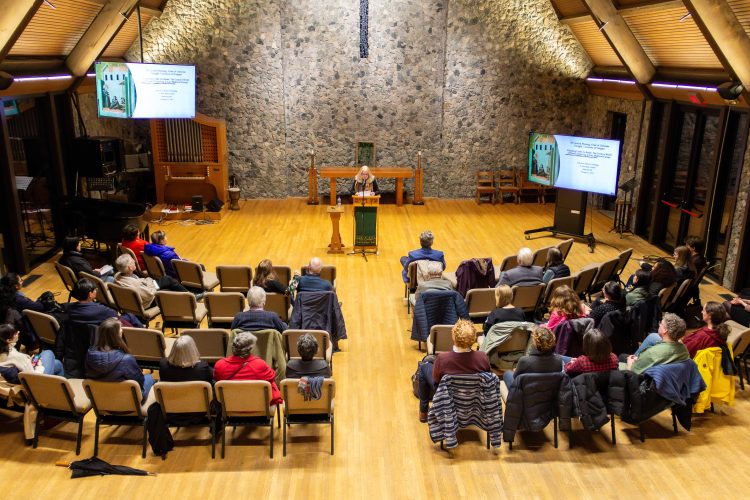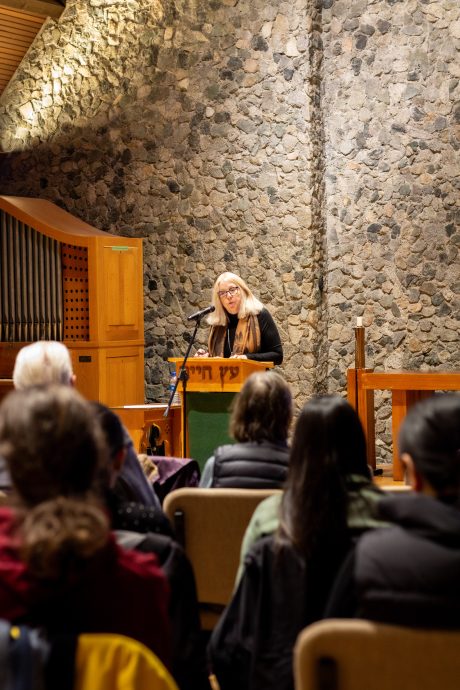Preaching Under the Radar: The Creative World of Female Preaching in Late Medieval Europe
A persistent misconception about premodern women in Western Europe (500–1600 CE) is that they lacked authority to speak openly about the Bible. This assumption stems partly from the belief that some biblical passages were binding and wholly restrictive in the Middle Ages. Examples of such verses include 1 Corinthians 14:34-35: “Let women keep silence in the churches, for it is not permitted to them to speak but to be subject, as also the law saith and shame for a woman to speak in the church;” as well as 1 Timothy 2:12: “But I suffer not a woman to teach nor to use authority.” Yet abbesses and nuns were respected teachers who preached to their sisters and, at times, to others—including men. Humility of Faenza (1226–1310) and Domenica of Paradiso (1473–1553) offer two striking Italian examples.
The noble and wealthy Humility of Faenza married in her mid-teens. In her 20s, she talked her reluctant husband into moving from the marriage bed to a cloistered cell, convincing him that that monasticism and not the married life was best for them both –– an early sign of Humility’s persuasiveness. In 1266, Humility founded the convent of Santa Maria near Faenza, becoming its abbess. It was the first Vallombrosan convent for nuns—a strict Benedictine branch previously limited to male houses. In 1282, she moved to Florence to establish St John the Evangelist, where she remained abbess until her death in 1310.
As an abbess, Humility had the legal right to preach—and she did. Nevertheless, her contemporaries portrayed her sermons as miraculously inspired rather than legally authorized. Hagiographers indicated that she dictated them while a pure white dove, with golden feet and beak, hovered by her ear. The dove, symbolizing the Holy Spirit, highlights a central theme in accounts of female preaching: that women’s pastoral authority was rooted in divine inspiration rather than formal training. Humility herself affirmed this in her sermons: “But you, brothers, who are about to hear my sermon, let it be known that the divine word that I speak is not from myself; but it remains with the Father of the Most High, God, who gives to each one as He wills. (cfr 1 Corinthians 12:11).” (Her address to “brothers” underscores that she preached not only to her nuns but also to men.)
In her sermons Humility recounts visionary dialogues with celestial figures, often including the Virgin Mary. These exchanges show that Mary is central to how Humility understood her call to preach. Humility explains that she was commanded by the Virgin to relate Christ’s life to others. Mary gave her a “new commandment,” echoing John 13:34. Mary told Humility to make a cover for the Christ-child, adorned with stars, earth, heaven, gems, and vibrant colours—a metaphor for Humility’s sermon composition. She calls the command a seed Mary sowed in her. Although Humility frets, believing herself to be “a dry and arid earth,” she obeys. This mirrors the Annunciation, with Mary as God planting the seed, while Humility becomes the Virgin bearing the Word—namely, her sermons on the life of Christ. Such theological imagination may be lost on modern readers who often interpret the Pauline verses for female silence as literally binding in the medieval context. Yet Humility, as a monastic woman deeply engaged with the New Testament, cultivated an intimate relationship with its figures.

G. Peter Kaye Lecture 2025 | Photo by Christopher Sanford Beck
The medieval religious imagination, rich in symbolism and tradition, provided premodern women with various means to reinterpret their place in a broader Christian narrative. Humility’s sermons reflect this textured devotional world, as when she likened sermon composition to weaving a cover for the Christ-child. The liturgy, art, and music surrounding Humility informed her sermons. Images that she would have seen in devotional art underpin her accounts of God, Mary and the saints. In one sermon she explains that she could see Mary in heaven whose beauty—especially her mouth—surpassed all else, as it conveyed eloquent words that captivated her listeners “purifying and refining their minds. Angels long to hear her, and saints rejoice in her voice. From her mouth and nostrils she breathes out such a flaming fragrance that in everyone it renews the desire to see her beautiful mouth because her lips are rosier and more sweet-smelling than a new rose.”
Humility’s portrayal of Mary’s eloquence celebrates the female voice, lingering in heaven like sweet perfume. Her vivid description of Mary’s inspiring words emanating from her sweet mouth offers both a precedent and an ideal to which Humility herself aspired. Like the Virgin, Humility spoke to ennoble the minds of her listeners urging her audience to stay on the path to perfection by heeding her sermons. In one sermon, Humility asks the angels to assist her with this pastoral task: “And sharpen my tongue like a razor to excise vices and plant virtues for the praise and glory of the highest emperor and his divine mother.” Humility understood her voice as a powerful instrument of transformation guiding listeners away from sin and toward spiritual renewal.
The medieval religious imagination, rich in symbolism and tradition, provided premodern women with various means to reinterpret their place in a broader Christian narrative.
Unlike Humility’s sermons, often framed as prophetic discourse, Domenica of Paradiso’s were sometimes described as preaching. Her humble origins make her story even more remarkable than Humility’s. Born outside of Florence in the suburb of Paradiso, she was the fifth of seven children of parents who were gardeners. As a girl she worked as a farm hand. Under pressure by her family to follow the traditional route of marriage and children, Domenica stood firm on her decision to lead a religious life.

G. Peter Kaye Lecture 2025 | Photo by Christopher Sanford Beck
In 1499, she moved to Florence, working as a textile laborer to support herself while embracing the spirit of religious reform associated with Girolamo Savonarola (1452–1498), the famed Dominican preacher of the friary of San Marco.
In 1498, a year before Domenica’s arrival in Florence, Savonarola was burnt at the stake. His prophetic preaching, fierce criticism of the Church, and political influence had sparked civic unrest and ultimately led to his execution. Nevertheless, his compelling teachings lived on. He preached that “God gives prophecy to whomever He wants, to men and women, and to high-born and low born.” The message must have resonated with Domenica given her background and religious inclinations. In fact, not long after arriving in Florence, she attracted a small following of wealthy men and women interested in her biblical interpretations. In 1501 she was accused of preaching in people’s homes. When brought before ecclesiastical authorities, she explained that she had done nothing more than speak the Word of God when divinely inspired—an argument that helped her avoid censure.
God welcomes all to speak of Him and places no limits on further interpretation.
Between 1504 and 1507, she interacted with the Dominicans of San Marco, several of whom became her spiritual advisors—including Santes Pagnino (1470–1536), a renowned biblical scholar ranked second only to Jerome (347–420) in Bible translation. She eventually distanced herself from the San Marco friars, whose spiritual guidance she and other Florentine women found overbearing. After ending her association with the Dominicans in 1509, Domenica chose Francesco Onesti da Castiglione (1463–1542), priest of San Lorenzo, as her spiritual father. In 1511, she founded the small convent of La Crocetta in Florence, largely funded by her wealthy followers, providing her with a place to preach. So Domenica, a laywoman from humble beginnings, who within ten years of arriving in Florence—originally as a textile worker—had gained enough respect and money as a gifted interpreter of scripture to build a new convent.
Domenica had a set routine for preparing her sermons. The night before she would begin by intoning the Psalm 51:17: “Oh Lord, you will open my lips and my mouth will announce your praise.” She then meditated on the biblical verse she would preach the next day. Once after reciting Psalm 51:17, Domenica recounted that the door of her cell flew open and three beautiful men entered, saying: “Peace be with you! We are the secretaries of the Most High God –– the secretaries and teachers, and guides who go teaching and guiding those who cry out to the Lord. God has heard your voice, and He has sent us to you: what do you ask?” However one interprets visions, this account reveals Domenica’s confidence that “God heard her voice”—and her eagerness to tell others. Like Humility, Domenica’s imaginative engagement with biblical texts went beyond a literal reading.
Domenica gave a sermon in July 1507. Its exact location is not known as it predates the construction of La Crocetta, but her audience included her “spiritual daughters” and three “spiritual fathers.” The sermon revolves around her vision of Paul who refutes an anti-feminine interpretation of 1 Corinthians 14:34. Paul tells Domenica that his command for silence referred only to the Corinthian women, who were disrupting his preaching—and that it was meant to apply only while he was speaking. He asserts that many women, filled with the Holy Spirit, have preached Christian doctrine without error. Honoured by the Church and now in heaven, they have done the will of their spouse—Christ—and have not contradicted 1 Corinthians 14:34.
Given her novel exegesis, it’s no surprise that over her 45-year preaching career, Domenica clashed with the Dominicans of San Marco and others who opposed her interpretations. For example, in 1519, she was accused of preaching heresy. Luckily, she had the backing of powerful men like Giulio de’ Medici (1478–1534), who was Cardinal of Florence, and later Pope Clement VII. Giulio cleared Domenica of all charges. Immediately after the inquest, Domenica wrote to her followers explaining that her interpretations of Scripture respected the Bible. She maintained that God welcomes all to speak of Him and places no limits on further interpretation.
Domenica occasionally preached at the request of followers such as Caterina Cibo (1501–1557), Duchess of Camerino, a powerful figure with sympathies toward Protestant reform. In 1534, Domenica preached a sermon to Caterina and her entourage. When she finished, Caterina requested another sermon—this time on Matthew 21:18–22, the parable of the cursed fig tree that Christ caused to wither. Domenica explained that she could not deliver a sermon on the spot. Rather she would first follow Paul’s advice from 1 Corinthians 14:34–35, that is, Domenica would remain silent, go home to the house of Christ her spouse and meditate because though the Holy Spirit often descends, the Holy Spirit does not explain. I love the irony—1 Corinthians 14:34–35, a passage often used to silence women, became central to Domenica’s sermon preparation. After considerable reflection, Domenica eventually honoured the Duchess’s request for another sermon, urging Caterina to recognize the importance of good works in salvation and not to follow Luther.
Humility and Domenica’s deep engagement with Scripture transcended legalistic, literal readings and compelled them to preach.
Humility and Domenica’s deep engagement with Scripture transcended legalistic, literal readings and compelled them to preach. Their ability to find a path to creative and powerful biblical interpretations was not only based on their intimate relationship with Scripture but on the respect that their contemporaries held for their privileged insights. Humility and Domenica were not isolated figures—other premodern women preached before and after them. These bold and imaginative exegetical voices are finally gaining recognition, but they still demand greater attention to secure their rightful place in religious history.
Carolyn Muessig is Chair of Christian Thought at the University of Calgary. A scholar of medieval religious culture, she has published on female spirituality, preaching, and miracles. Formerly at the University of Bristol, she is Vice President of the International Medieval Sermon Studies Society and is researching premodern female preaching.
